Zhanhui Zhou
SafeWork-R1: Coevolving Safety and Intelligence under the AI-45$^{\circ}$ Law
Jul 24, 2025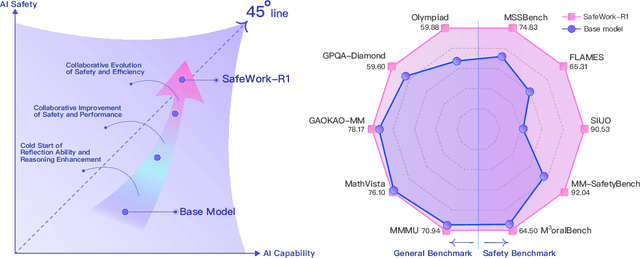
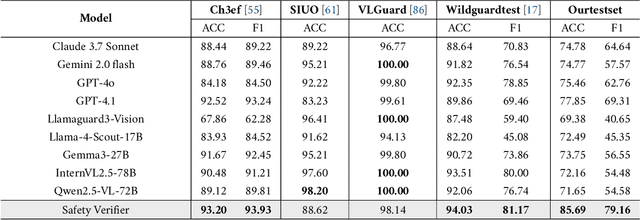
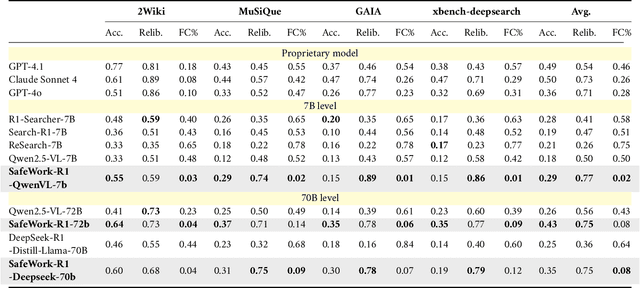

Abstract:We introduce SafeWork-R1, a cutting-edge multimodal reasoning model that demonstrates the coevolution of capabilities and safety. It is developed by our proposed SafeLadder framework, which incorporates large-scale, progressive, safety-oriented reinforcement learning post-training, supported by a suite of multi-principled verifiers. Unlike previous alignment methods such as RLHF that simply learn human preferences, SafeLadder enables SafeWork-R1 to develop intrinsic safety reasoning and self-reflection abilities, giving rise to safety `aha' moments. Notably, SafeWork-R1 achieves an average improvement of $46.54\%$ over its base model Qwen2.5-VL-72B on safety-related benchmarks without compromising general capabilities, and delivers state-of-the-art safety performance compared to leading proprietary models such as GPT-4.1 and Claude Opus 4. To further bolster its reliability, we implement two distinct inference-time intervention methods and a deliberative search mechanism, enforcing step-level verification. Finally, we further develop SafeWork-R1-InternVL3-78B, SafeWork-R1-DeepSeek-70B, and SafeWork-R1-Qwen2.5VL-7B. All resulting models demonstrate that safety and capability can co-evolve synergistically, highlighting the generalizability of our framework in building robust, reliable, and trustworthy general-purpose AI.
SafeCoT: Improving VLM Safety with Minimal Reasoning
Jun 11, 2025Abstract:Ensuring safe and appropriate responses from vision-language models (VLMs) remains a critical challenge, particularly in high-risk or ambiguous scenarios. We introduce SafeCoT, a lightweight, interpretable framework that leverages rule-based chain-of-thought (CoT) supervision to improve refusal behavior in VLMs. Unlike prior methods that rely on large-scale safety annotations or complex modeling, SafeCoT uses minimal supervision to help models reason about safety risks and make context-aware refusals. Experiments across multiple benchmarks show that SafeCoT significantly reduces overrefusal and enhances generalization, even with limited training data. Our approach offers a scalable solution for aligning VLMs with safety-critical objectives.
RePO: Replay-Enhanced Policy Optimization
Jun 11, 2025Abstract:Reinforcement learning (RL) is vital for optimizing large language models (LLMs). Recent Group Relative Policy Optimization (GRPO) estimates advantages using multiple on-policy outputs per prompt, leading to high computational costs and low data efficiency. To address this, we introduce Replay-Enhanced Policy Optimization (RePO), which leverages diverse replay strategies to retrieve off-policy samples from a replay buffer, allowing policy optimization based on a broader and more diverse set of samples for each prompt. Experiments on five LLMs across seven mathematical reasoning benchmarks demonstrate that RePO achieves absolute average performance gains of $18.4$ and $4.1$ points for Qwen2.5-Math-1.5B and Qwen3-1.7B, respectively, compared to GRPO. Further analysis indicates that RePO increases computational cost by $15\%$ while raising the number of effective optimization steps by $48\%$ for Qwen3-1.7B, with both on-policy and off-policy sample numbers set to $8$. The repository can be accessed at https://github.com/SihengLi99/RePO.
Mitigating Object Hallucination via Robust Local Perception Search
Jun 07, 2025Abstract:Recent advancements in Multimodal Large Language Models (MLLMs) have enabled them to effectively integrate vision and language, addressing a variety of downstream tasks. However, despite their significant success, these models still exhibit hallucination phenomena, where the outputs appear plausible but do not align with the content of the images. To mitigate this issue, we introduce Local Perception Search (LPS), a decoding method during inference that is both simple and training-free, yet effectively suppresses hallucinations. This method leverages local visual prior information as a value function to correct the decoding process. Additionally, we observe that the impact of the local visual prior on model performance is more pronounced in scenarios with high levels of image noise. Notably, LPS is a plug-and-play approach that is compatible with various models. Extensive experiments on widely used hallucination benchmarks and noisy data demonstrate that LPS significantly reduces the incidence of hallucinations compared to the baseline, showing exceptional performance, particularly in noisy settings.
Emergent Response Planning in LLM
Feb 10, 2025



Abstract:In this work, we argue that large language models (LLMs), though trained to predict only the next token, exhibit emergent planning behaviors: $\textbf{their hidden representations encode future outputs beyond the next token}$. Through simple probing, we demonstrate that LLM prompt representations encode global attributes of their entire responses, including $\textit{structural attributes}$ (response length, reasoning steps), $\textit{content attributes}$ (character choices in storywriting, multiple-choice answers at the end of response), and $\textit{behavioral attributes}$ (answer confidence, factual consistency). In addition to identifying response planning, we explore how it scales with model size across tasks and how it evolves during generation. The findings that LLMs plan ahead for the future in their hidden representations suggests potential applications for improving transparency and generation control.
Inference-Time Language Model Alignment via Integrated Value Guidance
Sep 26, 2024Abstract:Large language models are typically fine-tuned to align with human preferences, but tuning large models is computationally intensive and complex. In this work, we introduce $\textit{Integrated Value Guidance}$ (IVG), a method that uses implicit and explicit value functions to guide language model decoding at token and chunk-level respectively, efficiently aligning large language models purely at inference time. This approach circumvents the complexities of direct fine-tuning and outperforms traditional methods. Empirically, we demonstrate the versatility of IVG across various tasks. In controlled sentiment generation and summarization tasks, our method significantly improves the alignment of large models using inference-time guidance from $\texttt{gpt2}$-based value functions. Moreover, in a more challenging instruction-following benchmark AlpacaEval 2.0, we show that both specifically tuned and off-the-shelf value functions greatly improve the length-controlled win rates of large models against $\texttt{gpt-4-turbo}$ (e.g., $19.51\% \rightarrow 26.51\%$ for $\texttt{Mistral-7B-Instruct-v0.2}$ and $25.58\% \rightarrow 33.75\%$ for $\texttt{Mixtral-8x7B-Instruct-v0.1}$ with Tulu guidance).
Iterative Length-Regularized Direct Preference Optimization: A Case Study on Improving 7B Language Models to GPT-4 Level
Jun 17, 2024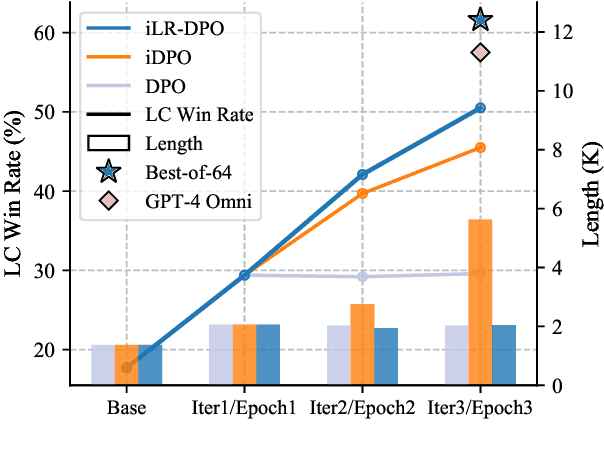
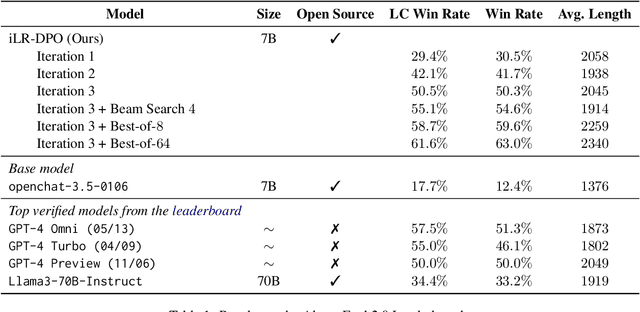

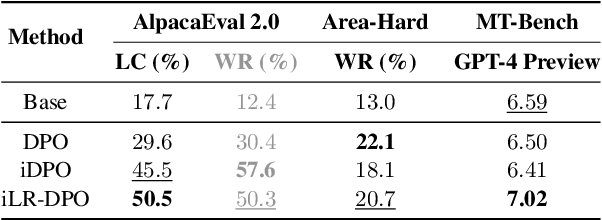
Abstract:Direct Preference Optimization (DPO), a standard method for aligning language models with human preferences, is traditionally applied to offline preferences. Recent studies show that DPO benefits from iterative training with online preferences labeled by a trained reward model. In this work, we identify a pitfall of vanilla iterative DPO - improved response quality can lead to increased verbosity. To address this, we introduce iterative length-regularized DPO (iLR-DPO) to penalize response length. Our empirical results show that iLR-DPO can enhance a 7B model to perform on par with GPT-4 without increasing verbosity. Specifically, our 7B model achieves a $50.5\%$ length-controlled win rate against $\texttt{GPT-4 Preview}$ on AlpacaEval 2.0, and excels across standard benchmarks including MT-Bench, Arena-Hard and OpenLLM Leaderboard. These results demonstrate the effectiveness of iterative DPO in aligning language models with human feedback.
Weak-to-Strong Search: Align Large Language Models via Searching over Small Language Models
May 29, 2024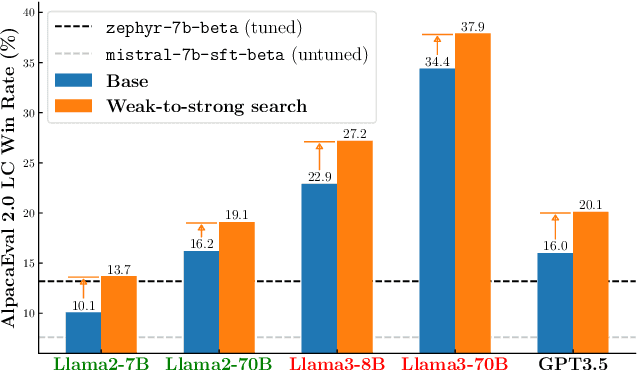
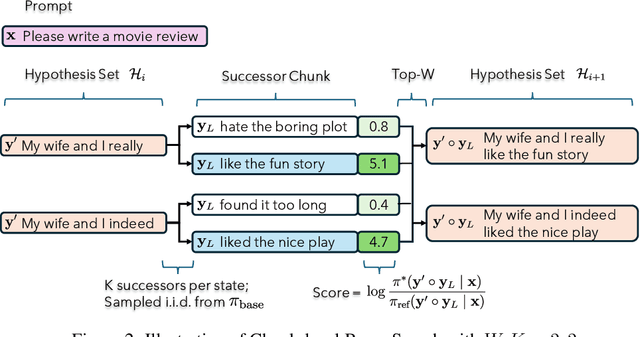
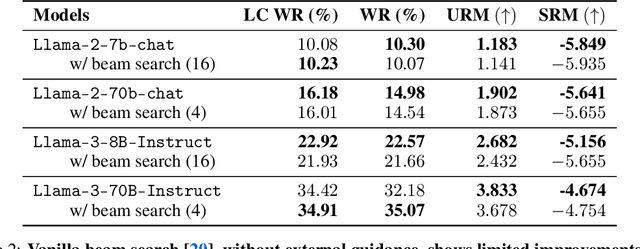
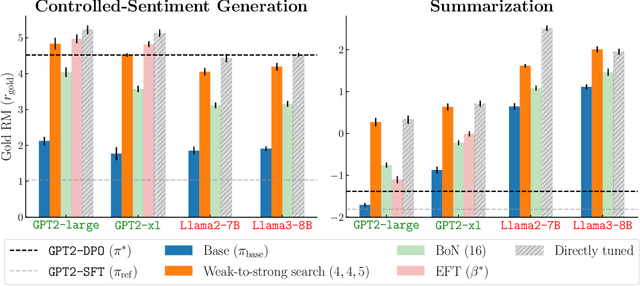
Abstract:Large language models are usually fine-tuned to align with human preferences. However, fine-tuning a large language model can be challenging. In this work, we introduce $\textit{weak-to-strong search}$, framing the alignment of a large language model as a test-time greedy search to maximize the log-likelihood difference between small tuned and untuned models while sampling from the frozen large model. This method serves both as (i) a compute-efficient model up-scaling strategy that avoids directly tuning the large model and as (ii) an instance of weak-to-strong generalization that enhances a strong model with weak test-time guidance. Empirically, we demonstrate the flexibility of weak-to-strong search across different tasks. In controlled-sentiment generation and summarization, we use tuned and untuned $\texttt{gpt2}$s to effectively improve the alignment of large models without additional training. Crucially, in a more difficult instruction-following benchmark, AlpacaEval 2.0, we show that reusing off-the-shelf small model pairs (e.g., $\texttt{zephyr-7b-beta}$ and its untuned version) can significantly improve the length-controlled win rates of both white-box and black-box large models against $\texttt{gpt-4-turbo}$ (e.g., $34.4 \rightarrow 37.9$ for $\texttt{Llama-3-70B-Instruct}$ and $16.0 \rightarrow 20.1$ for $\texttt{gpt-3.5-turbo-instruct}$), despite the small models' low win rates $\approx 10.0$.
ConceptMath: A Bilingual Concept-wise Benchmark for Measuring Mathematical Reasoning of Large Language Models
Feb 23, 2024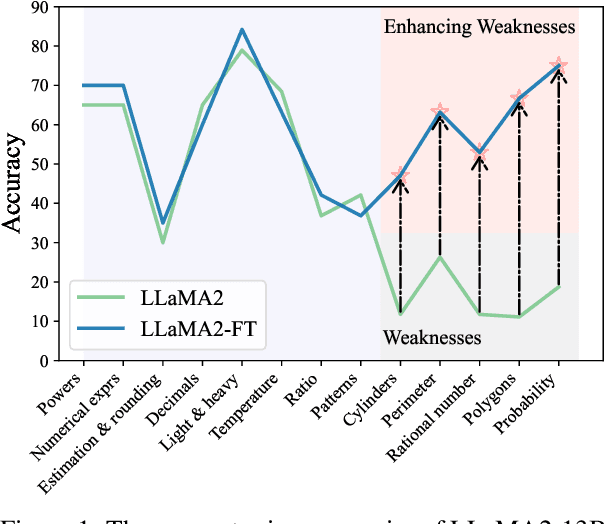
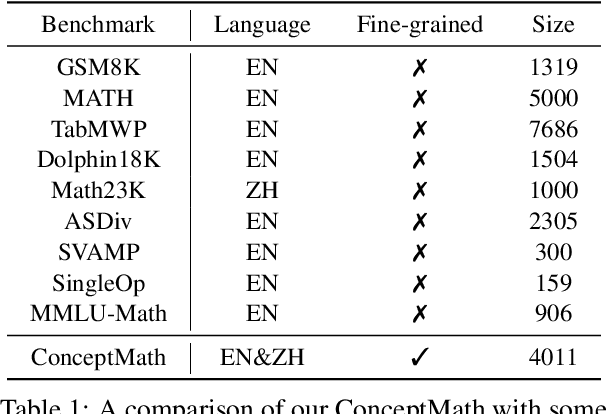
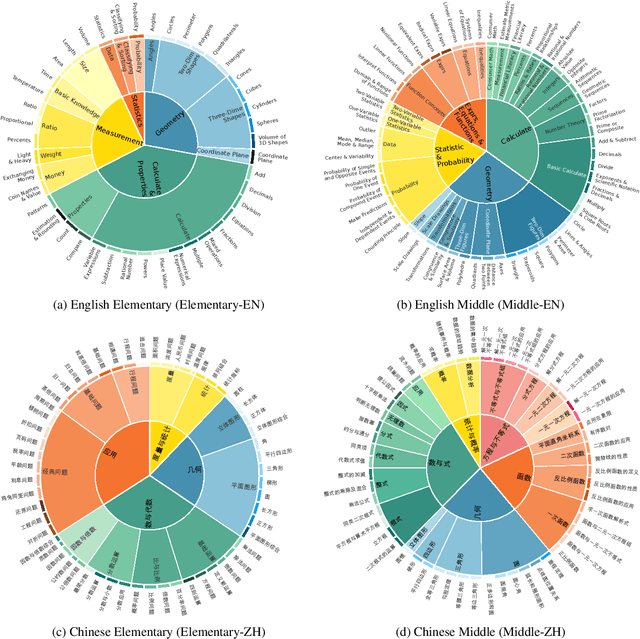
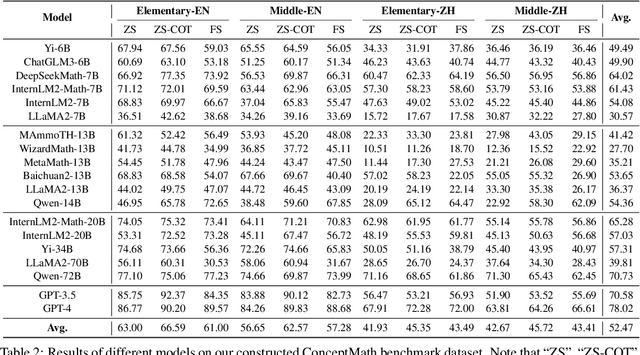
Abstract:This paper introduces ConceptMath, a bilingual (English and Chinese), fine-grained benchmark that evaluates concept-wise mathematical reasoning of Large Language Models (LLMs). Unlike traditional benchmarks that evaluate general mathematical reasoning with an average accuracy, ConceptMath systematically organizes math problems under a hierarchy of math concepts, so that mathematical reasoning can be evaluated at different granularity with concept-wise accuracies. Based on our ConcepthMath, we evaluate a broad range of LLMs, and we observe existing LLMs, though achieving high average accuracies on traditional benchmarks, exhibit significant performance variations across different math concepts and may even fail catastrophically on the most basic ones. Besides, we also introduce an efficient fine-tuning strategy to enhance the weaknesses of existing LLMs. Finally, we hope ConceptMath could guide the developers to understand the fine-grained mathematical abilities of their models and facilitate the growth of foundation models.
MT-Bench-101: A Fine-Grained Benchmark for Evaluating Large Language Models in Multi-Turn Dialogues
Feb 22, 2024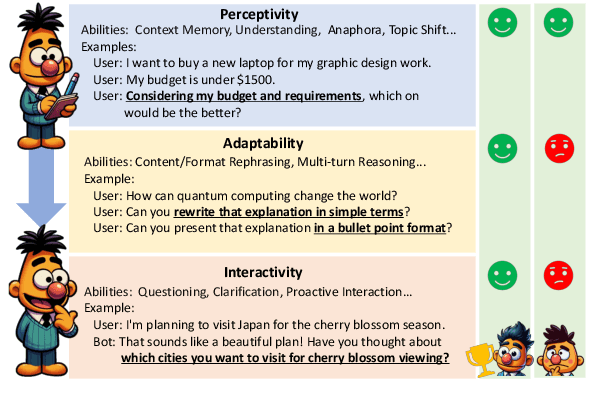
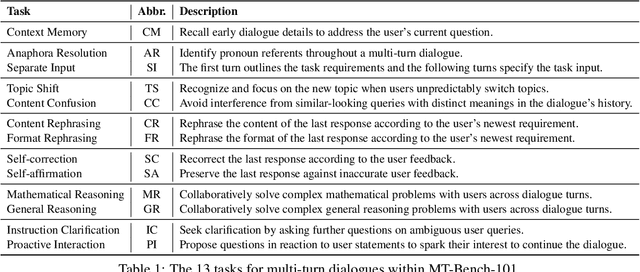
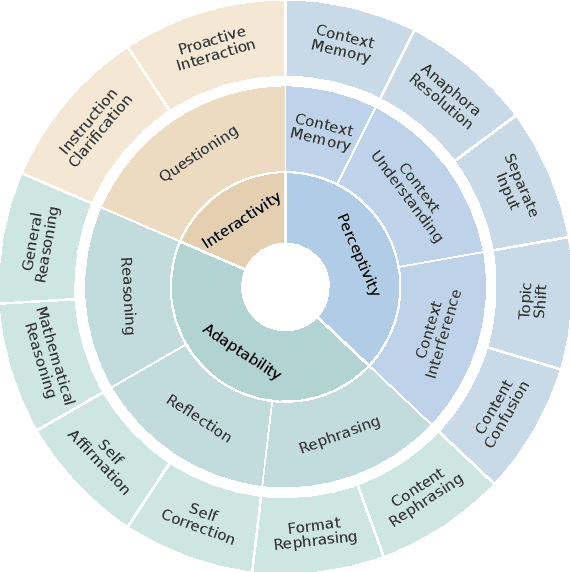
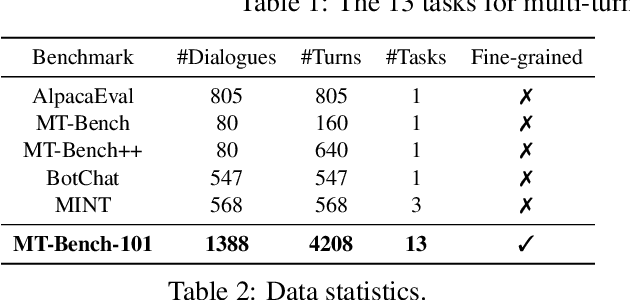
Abstract:The advent of Large Language Models (LLMs) has drastically enhanced dialogue systems. However, comprehensively evaluating the dialogue abilities of LLMs remains a challenge. Previous benchmarks have primarily focused on single-turn dialogues or provided coarse-grained and incomplete assessments of multi-turn dialogues, overlooking the complexity and fine-grained nuances of real-life dialogues. To address this issue, we introduce MT-Bench-101, specifically designed to evaluate the fine-grained abilities of LLMs in multi-turn dialogues. By conducting a detailed analysis of real multi-turn dialogue data, we construct a three-tier hierarchical ability taxonomy comprising 4208 turns across 1388 multi-turn dialogues in 13 distinct tasks. We then evaluate 21 popular LLMs based on MT-Bench-101, conducting comprehensive analyses from both ability and task perspectives and observing differing trends in LLMs performance across dialogue turns within various tasks. Further analysis indicates that neither utilizing common alignment techniques nor chat-specific designs has led to obvious enhancements in the multi-turn abilities of LLMs. Extensive case studies suggest that our designed tasks accurately assess the corresponding multi-turn abilities.
 Add to Chrome
Add to Chrome Add to Firefox
Add to Firefox Add to Edge
Add to Edge